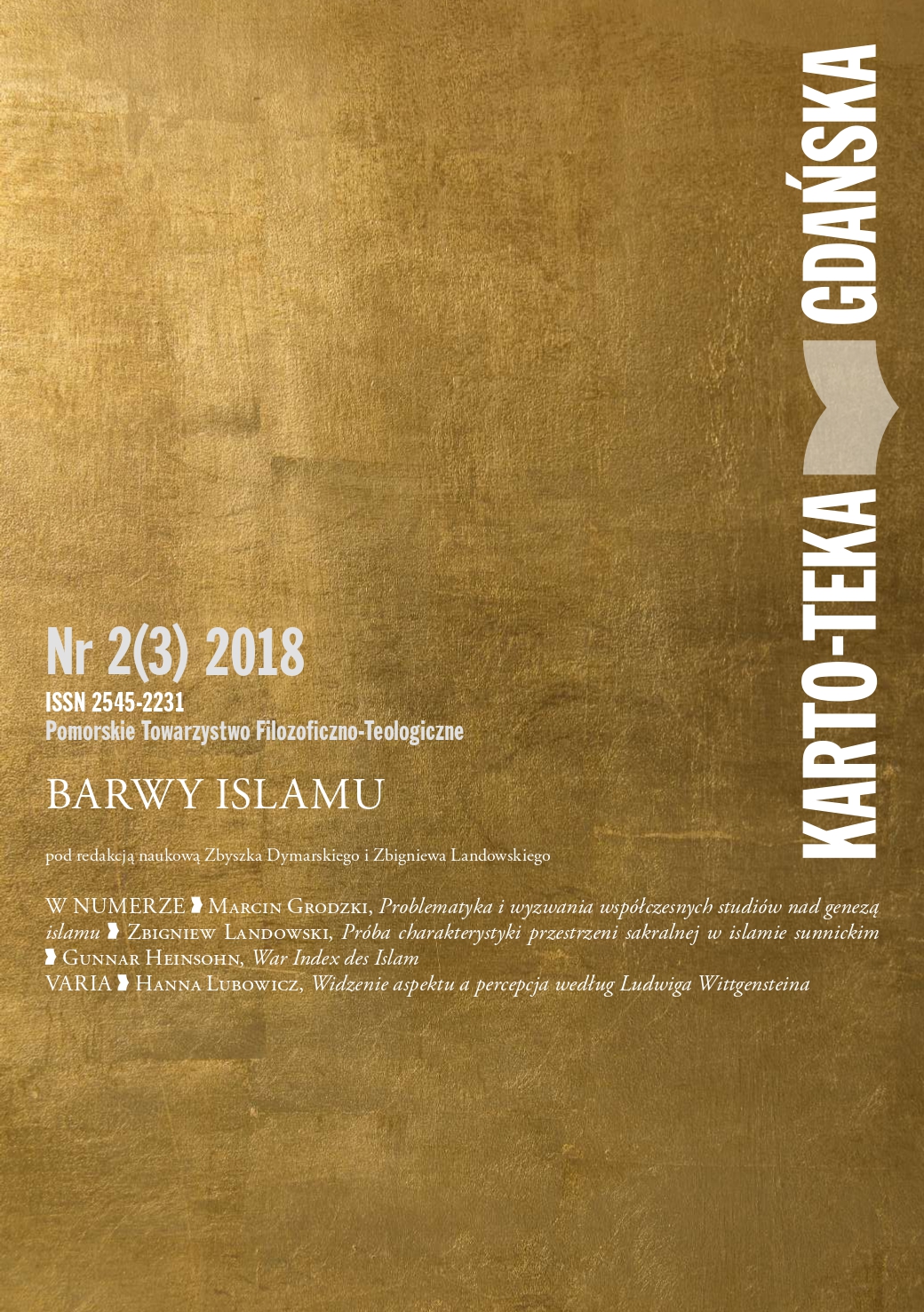Islamski index wojny
Słowa kluczowe:
demography, war index, war history, religion as pretextAbstrakt
W latach 1900–2015, światowa populacja muzułmanów wzrosła dziewięciokrotnie: od 200 mln do 1,8 mld osób. Mimo że chrześcijaństwo jest nadal największą religią na świecie, to populacja wewnątrz tej grupy religijnej wzrosła tylko o cztery razy (z 560 mln do 2,3 mld). Począwszy od 1950 roku islam, jako religia, powiększył liczbę swych wyznawców prawie do 1,4 miliarda osób (to tylu ludzi, ilu żyje w Chinach lub czterokrotna liczba ludności USA). Zamieszki na Bliskim Wschodzie są skutkiem, przede wszystkim, gwałtownego wzrostu liczby dorastającej młodzieży i jednoczesnego upadku gospodarki.
Downloads
Bibliografia
Altmann, I., Horn, J. P., Hg., “To Make America”: European Emigration in the Early Modern Period, Berkeley et al. University of California Press, 1991.
Amrehn, B., „Deutsche in der Fremdenlegion“, Planet Wissen, 2017 (online): <https://www.planetwissen.de/geschichte/deutsche_geschichte/deutsche_in_der_franzoesischen_fremdenlegion/pwiedeutschereinfluss100.html>.
Baker, J.A., Hamiltion, L.H., The Iraq Study Group Report, (online): <https://web.archive.org/web/20090601191410/http://www.usip.org/isg/iraq_study_group_report/report/1206/iraq_study_group_report.pdf>.
Bouthoul, G., Kindermord aus Staatsraison: Der Krieg als bevölkerungspolitischer Ausgleich (1970), Stuttgart: DVA 1972.
Esipova, N., Ray, J., „700 Million Worldwide Desire to Migrate Permanently“, 2009, (online): <http://www.gallup.com/poll/124028/700-million-worldwide-desire-migrate-permanently.aspx>.
Füssel, M., Der Siebenjährige Krieg: Ein Weltkrieg im 18. Jahrhundert, München: C.H. Beck.
Goltz, C. von der (1883), Das Volk in Waffen: Ein Buch über Heerwesen und Kriegführung unserer Zeit, Berlin: Decker 2013.
Hatcher, J., Plague, Population and the English Economy 1348-1530, London: Palgrave 1977.
Heinsohn, G., Söhne und Weltmacht: Terror im Aufstieg und Fall der Nationen, Zürich: Orell & Füssli 2003.
Heinsohn, G. (2006), Babies win wars, „Wall Street Journal“, 6. März 2006, (online): <https://www.wsj.com/articles/SB114159651882789812>.
Heinsohn, G., Wer folgt auf Mubarak?, „Focus“, Nr. 6, 7. Februar 2011a, (online): <https://www.focus.de/magazin/archiv/titel-werfolgt-auf-mubarak_aid_597479.html>.
Heinsohn, G. (2011b), „Bruderkriegsindex der arabischen Aufstände“, 8. Februar 2011b, (online): <http://www.achgut.com/artikel/bruderkriegsindex_der_arabischen_aufstaende/>.
Heinsohn, G., Security Perspectives of Demographic Trends, lecture, NATO Defense College (NCD), Rom, 28. Mai 20018.
Heinsohn, G., Steiger, O., Die Vernichtung der Weisen Frauen (19851), Augsburg: März 2005.
Heinsohn, G., Steiger, O., Ownership Economics: On the Foundations of Interest, Money, Markets, Business Cycles and Economic Development, hgg. V. F. Decker, London: Routledge 2013.
Hirschfeld, M., Geschlecht und Verbrechen, Leipzig & Wien: Schneider 1930.
Ingraham, B., Marching to War: France, Great Britain, and the United States face Ho Chi Minh’s guerilla army, 2015, (online): <http://www.ephemeraltreasures.net/marching-to->.
Jung, J.-H., Lehrbuch der Staats-Polizey Wissenschaft, Leipzig: Weidmann 1788.
Kolb, C., Geschätzte Bevölkerungsentwic zwischen 962 und 1806, 2018, (online): <https://www.xn-heiliges-rmisches-reich-hlc.de/bevoelkerung.html>.
Münkler, H., Der Dreißigjährige Krieg. Europäische Katastrophe, deutsches Trauma 1618–1648, Berlin: Rowohlt 2017.
Münkler, H., Der ewige Krieg, „Die Zeit“, 18. Mai 2018, (online): <https://www.zeit.de/zeit-geschichte/2017/05/kriege-dreissigjaehriger-krieg-syrien-libyen-vergleich/komplettansicht>.
Nietzsche, F., Die fröhliche Wissenschaft, Chemnitz: Schmeltzner 1882.
PEW, About half or more in several sub-Saharan African countries would move to another country, 2017, (online): <http://www.pewglobal.org/2018/03/22/at-least-a-million-sub-saharan-africans-moved-to-europe-since-2010/ph-03-22-18_africa-final-01/>.
Population Reference Bureau, World Population Growth Through History, United Nations: Population Reference Bureau 2006.
Populstat, Population Statistics: historical demography of all countries, their divisions and towns, 2006, (online): <http://www.populstat.info/>.
Rindermann, H., Cognitive Capitalism: Human Capital and the Wellbeing of Nations, Cambridge: Cambridge University Press 2018a.
Rindermann, H., Appendix Cognitive ability measures, 2018b, (online): <https://www.tu-chemnitz.de/hsw/psychologie/professuren/entwpsy/team/rindermann/pdfs/RindermannCogCapAppendix.pdf>.
Salewski, M., Der Erste Weltkrieg, Paderborn: Ferdinand Schöningh 2003.
Salewski, M., Unfähige Maschinisten des Machtgetriebes, „Frankfurter Allgemeine Zeitung“, 21. März 2006.
Sprenger, J., Institoris, H., Malleus Maleficarum. Der Hexenhammer [1487], hgg. v. J. W. R. Schmidt, Nachdruck Darmstadt: Wissenschaftliche Buchgesellschaft, 1974, III Bände, 2006.
White, M., Necrometrics: Death Tolls across history¸ 2014, (online): <http://necrometrics.com/>.
Wilkinson, R., Pickett, K., The Inner Level. How More Equal Societies Reduce Stress, Restore Sanity and Improve Everyone’s Wellbeing, London: Allen Lane 2018.
Wilson, P.H., Der Dreißigjährige Krieg: Eine europäische Tragödie, Stuttgart: Theiss, 2017.
Wilson, P.H., Interview mit Moritz Schwarz, „Junge Freiheit“, 18. Mai 2018, s. 3.
World Bank, International migrant stock, 2015, (online): <https://data.worldbank.org/indicator/SM.POP.TOTL.ZS?view=chart>.
WPP = World Population Prospects, United Nations: DESA / Population Division, 2017, (online): <https://esa.un.org/unpd/wpp/DataQuery/>.

 Uniwersyteckie Czasopisma Naukowe
Uniwersyteckie Czasopisma Naukowe

